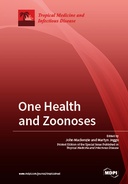Explore

One Health and Zoonoses
John S. Mackenzie and Martyn Jeggo
2019
0 Ungluers have
Faved this Work
Login to Fave
The One Health concept recognizes that the health of humans, animals, and their ecosystems are interconnected, and that a coordinated, collaborative, multidisciplinary, and cross-sectoral approach is necessary to fully understand and respond to potential or existing risks that originate at the animal–human–ecosystems interfaces. Thus, the One Health concept represents a holistic vision for addressing some of the complex challenges that threaten human and animal health, food safety, and the environments in which diseases flourish. There are many examples showing how the health of humans is related to the health of animals and the environment. Diseases shared between humans and animals are zoonoses. Some zoonoses have been known for many years, whereas others have emerged suddenly and unexpectedly. Over 70% of all new emerging diseases over the past few decades have been zoonoses that have emerged from wildlife, most often from bats, rodents, or birds. Examples of zoonoses are many and varied, ranging from rabies to bovine tuberculosis, and from Japanese encephalitis to SARS. Clearly, a One Health approach is essential for understanding their ecology, and for outbreak response and the development of control strategies. However, the One Health concept and approach is much broader than zoonoses; it extends to including antimicrobial resistance, food safety, and environmental health and, consequently, impacts on global health security, economic wellbeing, and international trade. It is this breadth of One Health that connects the papers in this Special Issue.
This book is included in DOAB.
Why read this book? Have your say.
You must be logged in to comment.
Rights Information
Are you the author or publisher of this work? If so, you can claim it as yours by registering as an Unglue.it rights holder.Downloads
This work has been downloaded 269 times via unglue.it ebook links.
- 229 - pdf (CC BY-NC-ND) at Unglue.it.
Keywords
- AMR
- antibiotics
- antimicrobial resistance
- antimicrobials
- Asia
- Australia
- Australian bat lyssavirus
- Brucella abortus
- C. burnetii
- clinical pattern
- Clostridium difficile
- Codex
- descriptive epidemiology
- Ebola Virus
- emerging disease
- emerging infectious diseases
- Environment
- Epidemiology
- food chain
- Guinea pigs
- Human
- incidence
- Influenza
- Infrastructure
- international health regulations
- Japanese encephalitis virus
- Joint External Evaluation (JEE)
- Luminex
- microbats
- mosquito
- n/a
- One Health
- Pandemic
- Performance of Veterinary Services (PVS)
- Prevalence
- pyrogenicity
- Q fever
- real-time PCR
- scrub typhus
- Serology
- smallholder farming
- surveillance
- Swine
- trade
- Transmission
- urban livestock keeping
- vector-borne disease
- Water
- Western australia
- WHO
- wildlife
- World Trade Organization (WTO)
- zoonoses
- zoonosis
Links
DOI: 10.3390/books978-3-03921-296-5Editions


